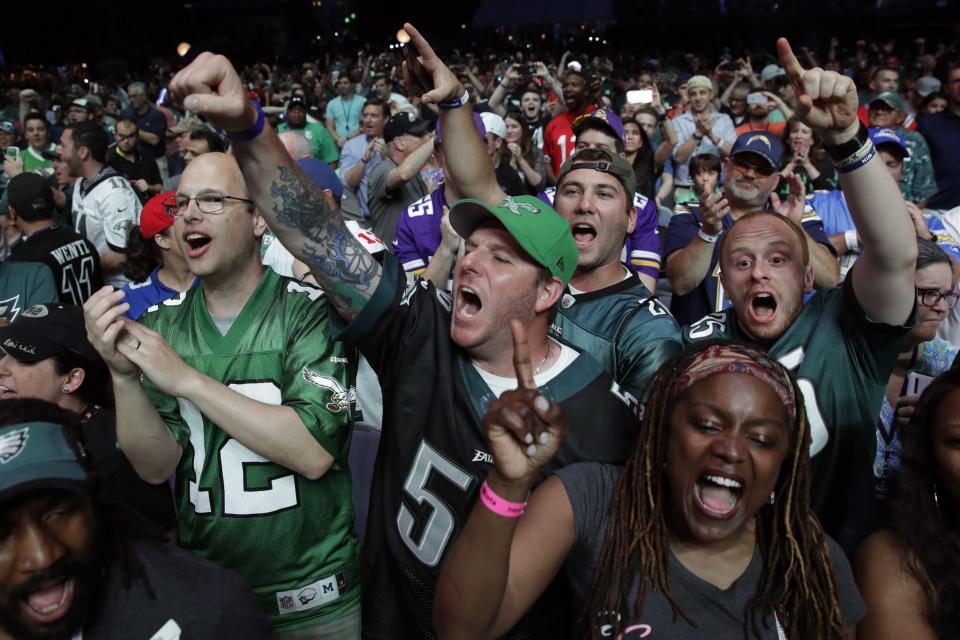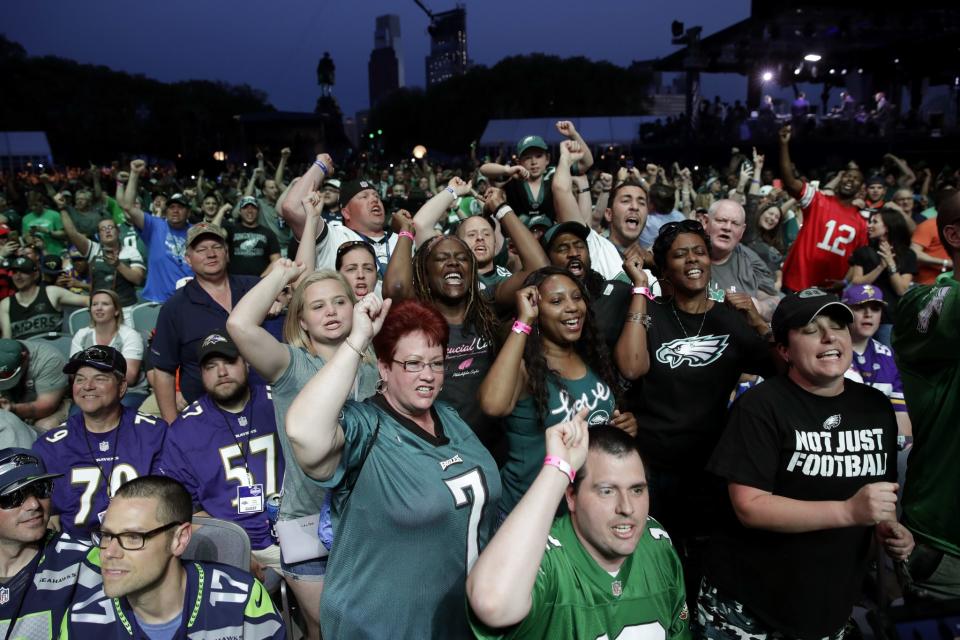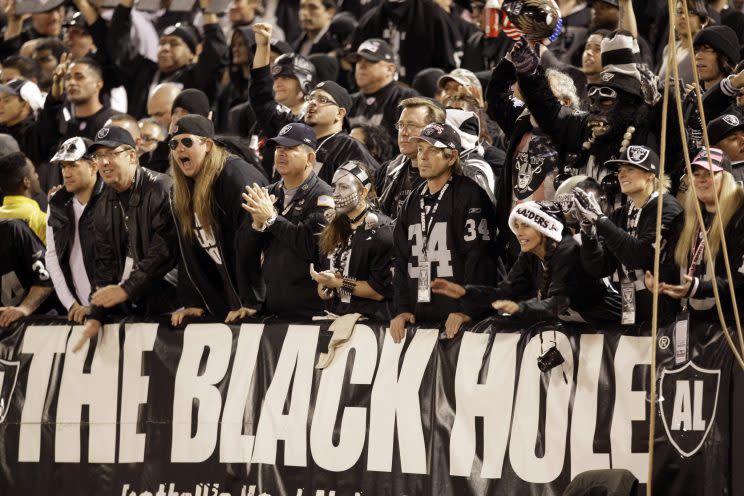Fans making NFL draft picks? It could be the next revolutionary step
Another NFL draft is in the books. We had suspense from a wild Round 1 down to intrigue with a recognizable Mr. Irrelevant (Chad Kelly).
By all accounts, it was another huge success in what has become a major obsession for fans. All you need to do is look at the first-round TV ratings and the quarter of a million people in Philadelphia who attended last week’s event to see how far and wide the draft’s reach has grown.
But it can grow more. In a way that would change sports.
The draft, to borrow journalism parlance, is the ultimate inverted pyramid: most newsworthy at the top, slowly narrowing down to the lesser details. And yet Kelly — who easily could have gone by the name Mr. Notorious for playing in the SEC and being the nephew of Hall of Famer Jim Kelly — is proof, however, that extremely talented players who are very well known to draft fans can still be on the board in the final stages.

When the draft is over, however, that’s when the madness kicks off in a flawed system for undrafted free agents, who suddenly are hindered in their quest to find a soft landing.
For years, agents have bemoaned the NFL’s free-for-all that ensues after the final pick. Teams call like mad to the agents of the undrafted, hoping to lowball them into signing, and agents say that the process begins prior to the end of the draft, which violates NFL rules. Teams will renege on deals without a moment’s notice. It’s the wild west of post-draft free agency, unchecked and unfair.
“Nobody is championing the rights of the undrafted players,” longtime NFL agent Ed Wasielewski told Shutdown Corner on Monday. “These guys … we put just as many resources into helping them before the draft, and they’re union members now. The union has a duty to these guys, and the league doesn’t care.
“The process is a mess and the teams don’t like to be called out for making an offer and then reneging when they get a commitment from another player. That’s just how this goes, and it needs to change.”
The NFL has no media programming for this phase of roster building, of course. If anything, it tries to keep it as hidden as possible. When the draft portion ends, ESPN and the NFL Network shut down their cameras and start packing up while this flurry of activity goes on. The next Tony Romo and James Harrison and Malcolm Butler likely signed with a team for a pittance on this past weekend, and you probably didn’t hear anything about it.
There’s a solution. The NFL is sitting on a potentially brilliant idea — one it already has considered and passed on for now — about making the draft even bigger. Two brilliant media pioneers, Mel Kiper Jr. and Joel Buchsbaum, helped turn the NFL draft from cottage industry into a billion-dollar affair. And believe it or not, the draft could ascend to new heights. But not before the league makes a major change — one that would come with a ton of controversy but also infinite fascination.
Fans actually voting on draft picks.
No, we have not lost our minds. The idea is brilliant. We’re honestly shocked that the NFL has yet to take such a step. It had the chance to start implementing this a little more than a year ago, Shutdown Corner learned, when a group that has patented the idea of a fan-selected portion of the draft (more on this in a minute) met with members of the NFL’s digital media and technology department at the owners meetings in Boca Raton, Florida.
A venture group known as The Final Round Draft, LLC pitched its idea to the league: The NFL draft will remain the standard seven rounds, but an eighth round would be added. With a moratorium on free-agent signings prior to Round 8, that final round would consist of fans voting for their favorite teams to sign one undrafted free agent apiece.
Imagine: All the fans who take to Twitter to bemoan their teams’ picks — and, lo, they are in the hundreds of thousands — now would have a true voice in the direction of the club. This is the kind of programming that is made for TV and digital media.
Think of it as reality TV and the NFL draft, two of the country’s biggest obsessions, converging. The draft’s answer to “Survivor,” “The Voice” or “Dancing With the Stars,” if you will — a fourth day of the draft that would break down the fourth wall. How this hasn’t happened yet is amazing.
The league heard Final Round Draft’s pitch and passed. “There was a meeting but there was no intent from our side to move forward,” NFL spokesman Brian McCarthy told Shutdown Corner in a statement. There’s a petition to support the idea online now.
The NFL has been seeking a way to expand the draft from three days to four ever since it changed it from a Saturday-Sunday affair to the three days (two in prime time) it is now. That unquestionably has been one of the successes of NFL commissioner Roger Goodell, who stood proudly as the boos rained down on him in Philadelphia all while counting dollar signs in his head.

There could be even more if the league changes its stance and adopts this radical idea. The NFL often is slow to change, and the idea of letting fans have a say in picking players won’t be met without resistance. Imagine the poor soul who would have to break the idea to Bill Belichick that Sully from Scituate is going to have a hand in selecting his next kick returner.
But Final Round Draft CEO Michael Morizio believes a league that has sought new revenue streams and put an emphasis on fan engagement could have a fruitful fourth day under their model.
“A ton of people watch the draft, we know that,” Morizio told Yahoo Sports. “But how many watch all the way until the end? How do you keep that fan engagement throughout? You can do that by giving the fans a voice.”
Morizio developed the eighth-round concept following his work as one of the founders of the “Moneyball” system used by Major League Baseball’s Oakland Athletics and their general manager, Billy Beane, in the early 2000s. The model sought to use analytics and other forward-thinking ideas (in a then-sometimes archaic-thinking sport) as a method to better scout and discover the next wave of under-the-radar talent.
The patent for fans making draft picks was developed by John Walters, a former NASCAR team owner who also played football at South Carolina. He partnered with Morizio and a small team with experience in baseball and football to refine the idea after several rounds of revisions a little more than two years ago. Now any professional sporting league in North America that wants to involve fans to help pick players will have to talk to the folks at The Final Round Draft.
The idea also might sit well with agents, who for years have been victim to the flawed post-draft system where teams lowball their clients with offers for roster spots in a flurry of phone calls. But sometimes those offers are not worth the breath in which they’re uttered as teams will rescind them as quickly as they hand them out.
“You’re forced to sometimes accept lowball deals without confirmed knowledge about the team’s situation for that position,” Wasielewski said. “We are operating in the dark, in a very small window of time, and without the benefit of seeing how teams’ depth charts are changing during the process. I’m looking for the best landing spot for each player. A team might be a horrible fit for a player, but we might not get another call. You’re taking deals because you’re sometimes worried no one else is going to call or a team is going to move onto the next player or just back out.
“If you have that moratorium, it allows the teams to send out emails to agents for which players they favor. It would give everyone time to breathe … some semblance of sanity. Right now, the present system simply doesn’t work effectively. It’s mayhem. For everyone involved — players, teams, and agents.”
Final Round Draft is proposing that undrafted free agents who are chosen by fans would also earn a nice little benefit: an upgraded, sponsor-driven financial package of at least $75,000 per player, or a luxury such as a new car. Plus, there would be the prestige and attention of being one of the select 32 picks that also could follow up with a “Hard Knocks” type of show, following the players as they seek to make their teams and earn even more recognition.
Although McCarthy’s statement indicated a setback toward getting the NFL on board, Morizio believes the momentum toward seeing a fan-driven draft is strong.
“The feedback we received was very positive,” Morizio said, “and we were encouraged to continue building out the technology.”
The company has formulated several external relationships since then, including adding the largest TV-voting company in the world, to help them ensure the integrity of the operation and prevent, say, a Dallas Cowboys fan voting for the Philadelphia Eagles to sign a 78-year-old guy from Dubuque. NFL teams actually would be able to vet and help slim down a pool of more than 12,000 draft-eligible prospects to the most desirable ones up for voting.
Could the NFL make it a reality for 2018 or beyond? If not, perhaps the NBA will beat it to the punch. Final Round Draft also has had positive conversations with the league that, frankly, has taken a more innovative and risk-taking approach toward marketing its game and broadening its fan engagement in recent years than the NFL.
So how might it happen in the NFL? Well, it likely would require ratifying the league’s CBA and bylaws, something that the owners and players likely would have to collectively sign off on. Morizio says it might be best to expand offseason rosters from 90 to 91 players in order to appease the hardline, old-school evaluators who feel that fans are taking a draft spot away from them.
If there’s resistance from general managers who would worry about fan-driven selections being better than the ones the scouts handpick, it’s a sign of insecurity. Any talent evaluator nervous about that probably shouldn’t be making picks in the first place.
“If I brought this to my owner and marketing department, they would eat it up,” one NFL general manager said. “It’s the way the league is trending. As long as teams have some say in the pool of candidates to choose from, I don’t think there would be a lot of resistance.”
Undrafted free agents make up a significant portion of NFL rosters. As much as 35 percent of the league is made from the undrafted ranks, and it’s not just the lesser teams tipping the scales with bottom-of-the-roster fodder. Thirty-three undrafted players were on the rosters of the two Super Bowl teams in February, the New England Patriots and Atlanta Falcons, and successful teams routinely spend significant resources finding hidden gems after the draft is over.
The interest would be strong if there was enough of a financial windfall. That would be the driving force of green-lighting such a radical development.
Plus, with Final Round Draft building up a year’s worth of hype online for next year’s prospects — offering up “Voice”-style hype videos on the players’ backgrounds, unique analytics and scouting reports for lesser-known talents who represent hidden or nearly undiscovered value — the interest would circumnavigate the calendar. We could start learning about next year’s gems now if we wanted to and follow their paths from under the radar to potentially starring in the NFL.
Final Round Draft would use its experience in analytics and sabermetric approaches to help identify the undervalued draft talent and present them to fans. That approach of locating hidden gems helped build up the A’s from also-rans to contenders, and it’s the same direction being taken by the Cleveland Browns — who are run by several analytics-driven front-office employees, led by “Moneyball” progenitor Paul DePodesta, now the Browns’ chief strategy officer and a man who has a large say in the team’s scouting strategies.
Some former NFL executives have been briefed on the “Round 8” idea and can envision a day when this becomes a reality. It would be the next step in draft expansion that has grown exponentially the past decade.
Remember who drives change in this league. Goodell carries out the orders of owners, who are profit-driven first and foremost. In some ways, Dallas Cowboys owner Jerry Jones is more the de facto commissioner than Goodell, as the past few years of NFL business have shown with the relocation of the Los Angeles Rams and the future Las Vegas Raiders.
If the owners think an idea can generate revenue — and perhaps a lot of it — they’re all for it. And they’re the ones who in essence call the shots. So if a money-making idea also comes with the auspice of connecting fans closer to the game, all the better.

With an extra day of the draft broadcast on two networks, there’s money to be made. And with apologies to the quaint novelty of Mr. Irrelevant, the draft is uninteresting by Day 3. Most people have tuned out.
But if fans have a say in the picks? You bet they’ll tune in.
In 2016, ESPN’s ratings were cut nearly by half, from a 2.0 rating with 3.02 million viewers Round 1 on Thursday night, down to Saturday’s 1.2 rating and 1.7 million viewers for Day 3, which represents Rounds 4 through 7. This year’s ratings were stronger on Days 1 and 2 but level for Day 3.
Morizio says a fan-driven eighth and final round standing alone on the fourth day of the draft could drive ratings back like a “V curve” — with perhaps almost as many people tuning in as the start as do the end. His thinking is that they potentially could be more invested, given a democratic say in helping their team find the next Romo, Butler, Harrison or Kurt Warner.
Who loses in this scenario? The NFL would gain revenue and attention. The agents could enjoy a cooling-off period and help their clients land in better situations. The teams would have one additional player on their roster, one whom fans immediately have a connection to.
That would be a win-win-win situation.
Fans are more knowledgeable and invested in the NFL draft than ever before. They spend hours reading reports and even watching game tape to find players they hope their team will draft. Right now, they can only cross their fingers hoping their team drafts the player they want most. But there might be a day where those fingers can be used to type in their vote for who their team should draft.
– – – – – – –
Eric Edholm is a writer for Shutdown Corner on Yahoo Sports. Have a tip? Email him at edholm@yahoo-inc.com or follow him on Twitter!
More from Yahoo Sports:
• Dan Wetzel: Aaron Hernandez’s latest legal drama begins to unfold
• Bears’ embarrassing draft request for QB
• Kaepernick, other big-name NFL free agents still looking for work
• MLB star taunted with racial slurs at Fenway
• Michael Lee: What’s fueling LeBron’s playoff dominance?




